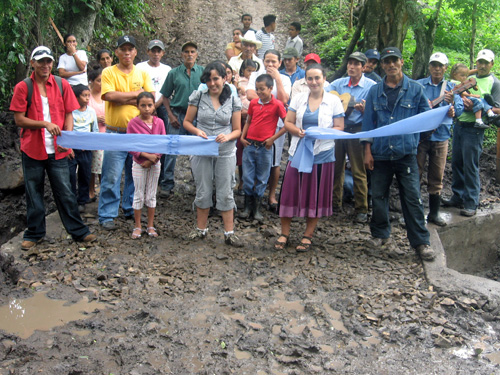
Editor’s Note: This is the sixth article in the World-At-Home series, in which we posit that one can “travel” around the world without leaving San Diego County, through interactions with the people and resources within the county.
By Donald H. Harrison

CARLSBAD, California –When Ana Reyes recalled her stint of a few summers ago as an Amigos de las Américas volunteer in the hamlet of El Quebrachal, Nicaragua, at times the animated UC Berkeley student laughed and on one occasion, she cried. Only 16 when she volunteered in 2009 as an amiga, Reyes and other volunteers, “were altered when they came back,” commented Joyce Mizock, president of the organization’s San Diego County chapter. “They had made a difference in the world that they didn’t know that they could make.”
The two neighbors were interviewed at Mizock’s home in an affluent eastern Carlsbad neighborhood, which is near the opposite end of the socio-economic scale from the simple community without electricity or indoor plumbing where Reyes had lived for six weeks with a host family. In El Quebrachal, located more than an hour’s walk up a mountain path from the city of Matagalpa, Reyes’ activities had included helping to build a small bridge so school children did not have to ford flood waters, serving as a teacher’s aide, lecturing on the importance of clean water, and comparing notes with children and adults about lifestyles of the United States and Nicaragua while sitting during the evenings in an outdoor circle illuminated only by a candle.
Since that summer, Reyes has returned twice to visit her hosts, the Rivas family, in the community of perhaps 150 persons—or 10 extended families. Reyes’ bond of affection with them—and with their neighbors—has become tightly woven. At one neighbor’s home, she was even surprised to find three pictures on the wall: a photo of that family, a portrait of Jesus, and a picture of her.
The residents of El Quebrachal perhaps would be dumbfounded to know that families whose teenage children volunteer in Amigos de las Américas donate a fee that by rural Nicaraguan standards would seem almost astronomical for the privilege of becoming their friends, their amigos. The donation,is $4,700 per volunteer. It covers $3,000 raised by each volunteer for project materials, round trip air transportation, as well as accommodations, living expenses and medical care for support staff who keep close tabs on the volunteers’ welfare.
Reyes, whose mother Silvia Dorta-Duque de Reyes served as the bilingual Spanish language director the San Diego County Office of Education, remembered that around the candle-lit outdoor circle, “we would talk about everything, about George Bush, about ‘is Obama’s wife pretty,’ and other questions like ‘what can you buy with a dollar in Nicaragua and what in the U.S.?” … I would say ‘a candy bar,’ and they would say, ‘for $1, that is so much money! Here you can buy a pound of rice, a pack of salt.’ They would ask ‘how much money does a teacher make?’ and I would answer, and they would say ‘that is a lot,’ and then they would ask ‘how much is rent?’ and they would realize that prices in the U.S. also are high.” At one point, the evening circle considered the issue of pay for a typical non-skilled job in the United States, “and I would say ‘$8 an hour,’ and they would say, ‘it would take a whole month to make $8.”
While this may sound like an exaggeration, it’s worth bearing in mind that the people of El Quebrachal are subsistence farmers, growing produce—corn, rice, and beans, which are staples of their diet, along with cucumbers and carrots. What little they have in surplus, they sell or barter on market days in Matagalpa, said Reyes.
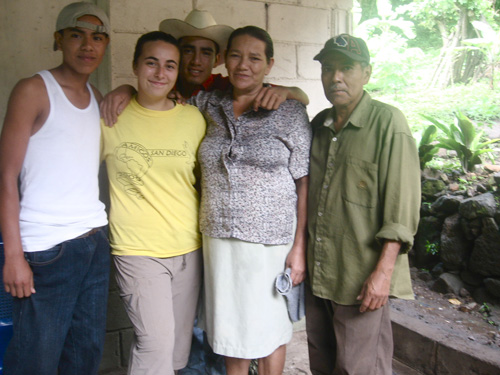
The typical wooden home of Lola and Bernardo Rivas had been replaced after one of Nicaragua’s periodic hurricanes with one made of cement blocks by a German non-governmental organization. It had a kitchen area, a store room and a common area, which the Rivas family partitioned with towels so that Reyes could sleep in privacy. The family has 14 children, but only three were young enough to still be living at home. Like her host family, Reyes used an outdoor latrine and showered in a three-sided outdoor stall utilizing water collected from pipes that served approximately five houses. For the sake of modesty, Reyes wore her bathing suit while showering.
By 4:30 a.m. every morning, Mrs. Rivas would be awake, making tortillas for the family breakfast, In the neighbors’ homes, other women were doing the same thing. Reyes said one could hear the pound- pound-pounding of tortilla-making, seemingly in unison, throughout the village. At the same time, the men were making ready to go to work, leaving their homes by 5:15 a.m. for the fields. At 7 a.m., the younger children would leave for school. Besides tortillas, breakfast consisted almost invariably of rice and beans “because it is hearty and good,” Reyes said. Sometimes on very special occasions, pork or chicken might be added to the menu, but “only for special occasions – because if you ever have an emergency you can sell your chickens (or pigs) quickly.” Farm animals represented what we might call the rainy day fund.
When Reyes would awaken, she would find breakfast waiting for her. Typically, Senora Rivas would offer her a cup of coffee, a beverage of which Reyes is not particularly fond. “Oh, I’ll just have water,” the teenager would often reply, and “they would say ‘why would you have water, when you can have coffee?’” For some of the volunteers, water was the more problematic of the beverages. They had been issued tablets by the Amigos organization to purify the water—which they were supposed to do discreetly—so as not to cause offense to their hosts. Reyes said she became used to the water and stopped using the tablets after a while, but not all volunteers had so resilient a constitution as she did.
After breakfast , Reyes would go to school, where she would help the teacher run games or arts activities. In the afternoon, back at home, she would help shell beans—a time that was both a work and social hour for the women of the village. On some afternoons she would attend community meetings organized by CARE International or other NGO’s at which such issues would be discussed as what makes a leader, and what kinds of projects does the community need. It was at such a meeting that it was decided to build a foot bridge in an oft-flooded area along the path to the school.
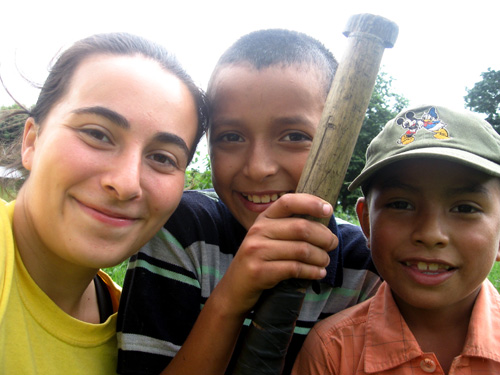
Later in the afternoon, after the men had returned from the fields, villagers would play a makeshift game of baseball, not on a baseball field, but in a field where the bases were but approximations. “You use a bat for so long and it can break, and we had one that broke into a kajillion pieces, and we said, ‘Oh man, we need a new bat,’ and one kid said, ‘Give me a machete, I’ll be back’ and he ran into the trees, and then he came back with a piece of wood, and chop! chop! chop!, and ‘okay, we have a bat, let’s go!’” and the game would resume until sunset.
Next came dinner, and afterwards, the outdoor circle—which Reyes’ considers the quintessential experience of her stay in Nicaragua—with conversation and camaraderie flowing.
“One of the guys … asked ‘Do people laugh in English the same as they do in Spanish? Do people cry the same as they do in Spanish?’ and half the old people were waiting for the answer, and the younger people were saying ‘that is a stupid question!’ Yeah, we laugh the same, and cry the same, and for the same reasons,” Reyes said she eventually replied. But, she said, laughing at the memory, she also made jokes, “’Oh no, we cry out of our ears!’ It was a funny question!”
There were other questions underscoring the differences between growing up in a rural village, largely cut off from the rest of the world, and in a suburban city in Southern California.
Once, Reyes showed photos from a high school prom she attended to the people of El Quebrachal. One of the photos was of a group of students in front of a limousine. “They said, ‘The President rides in a limo!’” and then the following conversation (translated from Spanish) occurred:
“You took a plane to get here, right?”
“Yes.”
“Wow, was it scary being in the air?”
She allowed that she doesn’t like flying.
“Have you been on a train?”
Yes
“A boat?”
Yes.
“A space ship?”
To the last questioner, other kids said, “are you stupid?” But the adults were waiting for the answer. For the adults it was, “Why not, she’s been in a limo!’”
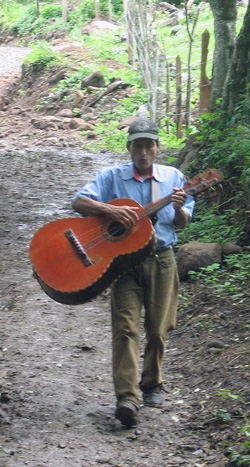
From this, one ought not to get the idea that the sophisticated girl from the United States taught the villagers of Nicaragua what life is really like. The reverse was closer to the truth. Reyes said she was impressed by the sense of community in El Quebrachal; how neighbors knew and cared about each other, and never felt the need to lock their doors. After her return home, she found herself wincing over how money is comparatively squandered in the United States. Going to the movies for a family of five costs $50, she said – imagine what a family back in El Quebrachal could do with $50. She told of one older student who had to drop out of school because he could not afford the $2 bus fare. That $50, so casually spent, could have paid for 25 days of school.
Although host families were provided cell phones in case of emergencies, volunteers are not permitted to have phones themselves as the experience is supposed to be “total immersion” in Spanish language and Nicaraguan culture. About halfway through the experience – the three-week mark—volunteers from throughout the region near Matagalpa had a retreat together to compare notes, wolf down hamburgers and French fries, and to take turns calling home. Reyes remembered that when she called home, her twin sister, Andrea, (today a UC-Irvine student) was the only one there. (Besides her mother and sister, her immediate family includes her father, Ricardo, and brother, Andy, a UCLA student). Fleetingly, Reyes told her sister of some of the people who made El Quebrachal special, including a ten-year-old boy, Lester, whom she described as her “Ninja buddy.”
El Quebrachal is so tiny, if you stuck a pin in a map of the world, it would perhaps more than cover the representative space occupied by the hamlet. Reyes had strong relationships with people in this tiny place that were so intense– and yet no one else important in her life had any idea of who these people were, or what they were like. Then came a letter from her sister, inquiring after her, and remembering to ask about “Lester, your Ninja buddy.” Reyes’ eyes misted over as she recollected that letter, the one that helped bring her two worlds together.
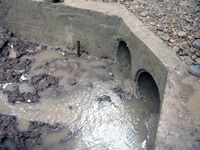
Before Reyes’ summer in El Quebrachal, perhaps no one would have imagined her prying rocks from the muck to clear the way for a cement footbridge. Perhaps the image of her and fellow volunteer Marissa Haines painting a mural on a school building would have been just as unlikely. But Reyes was game for these various activities—and if ever she’d have been invited by the village men—she’d have liked to have tried her hand in the fields tending to the crops. Joyce Mizock said volunteering with Amigos builds a teenager’s self-confidence and willingness to try new things. She recalled that her own daughter, Lindsey, who had worked in Oaxaca, Mexico, came home and announced, “I’m pretty much not afraid of anything anymore.”
Amigos de las Américas, as implied by its name, fields volunteers throughout Latin America. Lindsey Mizock and Ana Reyes, friends since they both were in third grade, were among nine students from San Dieguito Academy who volunteered for the program in 2009. The San Diego chapter of Amigos de las Américas has been growing exponentially and Joyce Mizock estimates that next summer it should be able to send out 30 student volunteers.
To qualify as a volunteer, one must have studied at least two years of high school Spanish, must be at least 16 years old in the September of the year of the trip; be able to pass an oral interview in Spanish, and commit to a code of conduct that includes prohibitions on drugs, alcohol, tobacco and “amorous” relationships during the time of the overseas experience.
The volunteers participate in a nine-month period of training, in which they are taught to deal with cultural differences, variations in living conditions, and how to protect their health. Scholarships are available for the program, which had its origins 46 years ago when a Baptist youth group in Texas trained and flew teenagers to Honduras to help inoculate children against polio. Today, Amigos de las Américas is a secular organization, with no religious affiliation. Indicative of that, Reyes is from a Catholic family, and the Mizocks are Jewish.
*
Harrison is editor of San Diego Jewish World. He may be contacted at donald.harrison@sdjewishworld.com